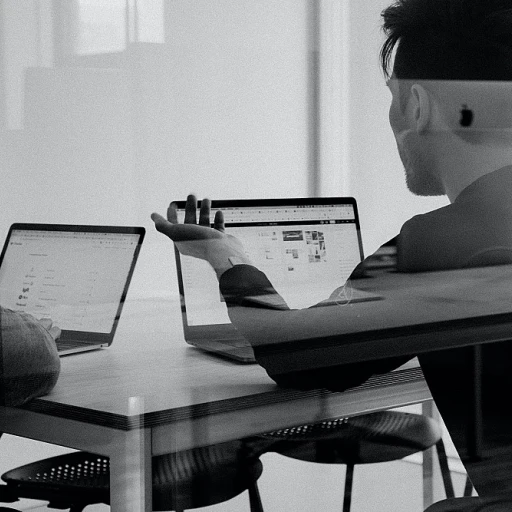
Understanding the needs of vision impaired tech professionals
Recognizing Unique Challenges in the Tech Workspace
Vision impaired professionals working in tech roles face a distinct set of challenges. From navigating complex software interfaces to managing daily living tasks at their desks, accessibility is not just a preference—it’s a necessity. The right keyboard can make a significant difference in productivity and comfort. For many, standard keyboards with small, low-contrast keys are simply not practical. Instead, features like large print, high-contrast color schemes (such as black on yellow or white on black), and tactile markers become essential.
Why Accessibility Matters in Keyboard Selection
Accessible keyboards are more than just tools—they are gateways to inclusion. For those with low vision or who are visually impaired, options like large print keyboards, braille overlays, and slimline keyboard designs can help bridge the gap between ability and opportunity. Accessories such as keyboard labels, magnifiers, and mini bluetooth keyboards further enhance usability. Even daily living aids like talking watches, alerting systems, and sonic alert devices play a role in creating a supportive tech environment.
- Large print keyboards: Offer bigger, bolder letters for easier identification.
- Black yellow or white black color schemes: Improve contrast and visibility.
- Braille and tactile markers: Support users who rely on touch.
- Mini and slimline options: Provide portability and comfort for different workspaces.
- Bluetooth connectivity: Allows flexibility and reduces cable clutter.
Balancing Price and Performance
When searching for the right keyboard, price and reviews are important factors. Many stores offer keyboards and accessories specifically designed for low vision users, often at a sale price. Comparing features and reading user reviews can help identify the best value. Some brands, like logickeyboard, specialize in accessible tech, while others offer a range of options including keyboard large print, mini bluetooth, and black white or black yellow models.
For organizations looking to improve their hiring tech and support vision impaired professionals, integrating accessible hardware is just one step. Enhancing recruitment efficiency with job board integration software can also help attract and retain diverse talent. For more on this, check out this resource on improving recruitment efficiency with job board integration software.
Key features to look for in accessible keyboards
Essential Accessibility Features for Vision Impaired Professionals
When selecting a keyboard for visually impaired or low vision tech professionals, it’s important to focus on features that directly address their daily challenges. Accessibility is not just about compliance—it’s about empowering productivity and comfort in the workplace. Here are the most important aspects to consider:
- Large Print and High Contrast: Keyboards with large print and high-contrast color schemes, such as black on yellow or white on black, make it easier to identify keys. Large print keyboards and keyboard labels are available in various styles, including black yellow and black white combinations, to suit individual preferences.
- Tactile and Braille Options: Some keyboards offer tactile markings or braille on keys, supporting users who rely on touch. Braille keyboards and accessories can be found in specialized stores, often alongside other assistive technology like canes and magnifiers.
- Backlighting and Illumination: Backlit keyboards or those with illuminated keys help users with low vision work in different lighting conditions. This feature is especially useful for professionals who work in varied environments.
- Ergonomics and Size: Slimline keyboards, mini keyboards, and mini bluetooth options provide flexibility for different workspaces. A keyboard large enough for comfortable typing but compact enough for mobility can be a game-changer.
- Durability and Daily Living Needs: Look for keyboards designed to withstand daily use. Some models are spill-resistant or come with accessories like keyboard covers. Reviews often highlight the durability and practicality of products, which is crucial for long-term use.
- Integration with Alerting Systems: For those who benefit from sonic alert or other alerting systems, check compatibility. Some accessible keyboards work seamlessly with daily living aids like talking watches, watches clocks, and alerting devices.
- Price and Value: Accessibility shouldn’t come at a prohibitive cost. Compare sale price, store options, and available discounts. Many reputable brands, such as logickeyboard, offer accessible keyboards at various price points. Always check reviews before making a purchase.
Beyond the keyboard itself, consider complementary tools like magnifiers, talking watches, and large print watches clocks to further support visually impaired professionals. For a deeper dive into evaluating vendors and ensuring your choices align with broader HCM systems, you can explore this guide to evaluating HR software companies.
Popular types of computer keyboards for vision impaired users
Accessible Keyboard Options for Low Vision and Blind Users
When it comes to choosing a keyboard for visually impaired professionals, the market offers a variety of solutions designed to address different needs. Selecting the right keyboard can make a significant difference in daily productivity and comfort. Here’s a look at some of the most popular types and their key features.
- Large Print Keyboards: These keyboards feature oversized letters and numbers, often in high-contrast color combinations like black on yellow or white on black. The large print makes it easier for low vision users to locate keys quickly. Some models, such as the slimline keyboard or keyboard large, are specifically designed for office environments, balancing accessibility with a professional look.
- Braille Keyboards: For users who are blind, braille keyboards or braille overlays provide tactile feedback. These can be standalone devices or accessories that attach to standard keyboards. Braille labels are also available for customizing existing keyboards.
- Mini and Bluetooth Keyboards: Compact options like mini bluetooth keyboards are ideal for professionals who need portability. Wireless connectivity adds flexibility, especially for those using assistive technology on the go.
- Keyboard Labels and Accessories: For those who want to adapt their current keyboard, large print keyboard labels in black, white, or yellow can be applied to keys. Accessories like magnifiers and daily living aids (such as talking watches, clocks, and sonic alert systems) can further support accessibility.
- Specialized Brands: Brands like logickeyboard offer a range of accessible keyboards, including models with large print, high contrast, and braille options. Many of these are available through dedicated low vision stores and online retailers, often at a sale price.
When comparing options, consider factors such as price, reviews, and compatibility with existing alerting systems or assistive technology. Some stores also offer bundles that include accessories like canes, watches clocks, and magnifiers. For organizations, integrating these solutions can be part of a broader strategy to streamline HR processes and support inclusion. For more on this, see streamlining HR processes with document management software.
| Keyboard Type | Key Features | Best For |
|---|---|---|
| Large Print Keyboard | High-contrast, large letters (black yellow, white black, print black) | Low vision, visually impaired |
| Braille Keyboard | Braille dots, tactile feedback | Blind users |
| Mini Bluetooth Keyboard | Portable, wireless, compact | Mobile professionals, assistive tech users |
| Keyboard Labels | Large print stickers, customizable | Adapting existing keyboards |
Ultimately, the right choice depends on the user’s vision needs, work environment, and personal preferences. Reading product reviews and checking for sale price options at specialized stores can help ensure the best fit for both individuals and organizations.
Integrating accessible keyboards into the workplace
Practical steps for workplace integration
Integrating accessible keyboards and related assistive technology into the workplace is essential for supporting vision impaired professionals. It’s not just about providing a keyboard large enough or with high-contrast print; it’s about creating an environment where everyone can work efficiently and comfortably. Here’s how organizations can approach this:
- Assess individual needs – Start by consulting with visually impaired employees to understand their preferences. Some may benefit from a large print keyboard, while others might prefer a slimline keyboard or a mini bluetooth model. Accessories like keyboard labels in black yellow or black white can further enhance usability.
- Offer a range of options – Stock a variety of keyboards and accessories. Consider large print, braille, and high-contrast options (such as black yellow or white black). Stores specializing in low vision products often have reviews and sale price information to help guide purchasing decisions.
- Ensure compatibility – Make sure that keyboards and assistive devices like magnifiers, talking watches, or alerting systems are compatible with existing IT infrastructure. Bluetooth keyboard options and mini keyboards can be ideal for flexible workstations.
- Provide training and support – Offer training sessions for both visually impaired professionals and their colleagues. This helps everyone understand how to use new devices, such as logickeyboard models or daily living aids like talking watches clocks and sonic alert systems.
- Maintain accessibility – Regularly review the effectiveness of the chosen solutions. Collect feedback, monitor the condition of equipment, and keep an eye on new products or accessories that may better serve your team, such as updated keyboard large print labels or mini canes for mobility.
Creating an inclusive tech environment
Beyond the keyboard, consider the full spectrum of assistive technology. Accessories like magnifiers, watches, clocks, and daily living aids can make a significant difference. Offering a dedicated store or resource center where employees can explore products—whether it’s a print keyboard, black print labels, or alerting systems—shows commitment to inclusion.
Ultimately, integrating accessible keyboards and related technology is not a one-time task. It’s an ongoing process that adapts to new needs, product reviews, and innovations in assistive technology. By prioritizing accessibility, organizations empower vision impaired professionals to thrive in tech roles.
Legal and ethical considerations in hiring tech
Complying with Accessibility Laws and Best Practices
Employers must ensure that their hiring processes and workplaces are accessible to all, including vision impaired professionals. In many countries, regulations such as the Americans with Disabilities Act (ADA) or the Equality Act require reasonable accommodations for employees with disabilities. This includes providing accessible technology like large print keyboards, braille keyboards, and accessories such as keyboard labels or magnifiers. Failing to comply can result in legal consequences and reputational damage.Evaluating Technology for Fairness and Inclusion
When selecting keyboards and related assistive technology, it’s important to consider not just the price or sale price, but also the actual needs of visually impaired users. Reviews from low vision professionals, as well as input from accessibility experts, can help identify the best options. Products like the logickeyboard, slimline keyboard, mini bluetooth keyboards, and black yellow or black white print keyboards should be evaluated for usability and comfort. Don’t overlook accessories such as talking watches, alerting systems, or daily living aids that support independence.Ethical Responsibility in the Workplace
Beyond legal compliance, there is an ethical obligation to foster an inclusive environment. Providing tools like large print keyboards, braille watches, or sonic alert systems demonstrates a commitment to supporting all employees. Employers should regularly review their technology offerings and seek feedback from visually impaired staff to ensure ongoing accessibility. This extends to offering a variety of solutions, from mini keyboards for portability to keyboard labels for customization, available through specialized stores or online sale platforms.- Ensure all technology, including keyboards and accessories, meets accessibility standards
- Consider the diverse needs of visually impaired professionals, from low vision to total blindness
- Regularly update and review assistive technology options based on user feedback and new product reviews
- Promote a culture of inclusion by providing training on assistive technology and accessibility best practices
Supporting ongoing accessibility and inclusion
Building a Culture of Accessibility Beyond the Keyboard
Supporting ongoing accessibility and inclusion for vision impaired professionals is not just about providing the right keyboard or large print accessories. It’s about creating a workplace where assistive technology is part of daily living, and everyone feels empowered to do their best work. Employers can take practical steps to ensure that accessible tools—like braille keyboards, black on yellow print keyboards, and mini bluetooth options—are not only available but also maintained and updated as needed. Regular reviews of available products, from slimline keyboard models to talking watches and sonic alert systems, help keep pace with evolving needs and technology.Continuous Training and Awareness
Ongoing training is essential. Staff should know how to use low vision aids, such as magnifiers, keyboard labels, and alerting systems. Training sessions can cover:- How to set up and use large print keyboards and accessories
- Integrating bluetooth keyboard solutions with existing systems
- Understanding the benefits of black white and black yellow contrast in keyboards and watches clocks
- Using daily living aids like talking watches and mini canes
Evaluating Products and Services
When selecting new products, consider:- Price and sale price options for budget planning
- Product reviews from other low vision professionals
- Availability of accessories and replacement parts in your preferred store
- Compatibility with existing assistive technology, such as mini bluetooth devices or print black labels
Fostering Inclusion Through Policy and Practice
Accessibility should be reflected in company policies and everyday practices. This includes:- Regularly updating technology and accessories for low vision staff
- Ensuring all new hires are aware of available assistive technology
- Providing easy access to stores or catalogs featuring large print, braille, and black yellow products
- Making sure alerting systems and sonic alert devices are tested and functional










